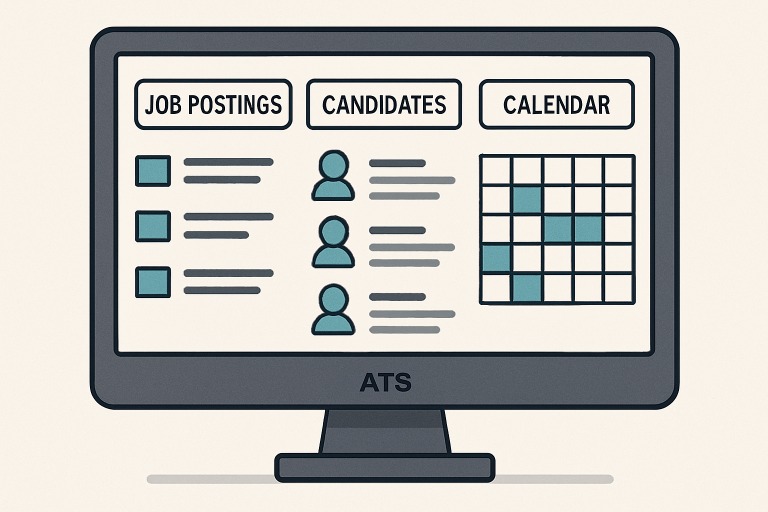Key Takeaways
- ATS platforms automate and centralize recruitment tasks, reducing time-to-hire.
- They enhance collaboration among hiring teams and improve candidate experience.
- Integration with other HR tools and compliance features makes ATS indispensable in modern hiring.
In today’s competitive job market, companies are turning to technology to streamline hiring and find the best candidates faster. Traditional recruitment methods often involve hours of manual screening, leading to delays and missed opportunities. To stay ahead, businesses are adopting tools that enhance efficiency and accuracy.
One such innovation is applicant tracking systems (ATS), platforms designed to automate and optimize recruitment workflows. But what is ATS software exactly? It’s a solution that helps HR teams collect, organize, and evaluate applications in one centralized system. From parsing resumes to ranking candidates based on qualifications, these systems minimize human error and speed up decision-making. As hiring demands continue to evolve, leveraging smart tools like ATS has become essential to modern recruitment success.
What Is an Applicant Tracking System?
An Applicant Tracking System is a specialized type of recruitment software that helps HR professionals manage every stage of the hiring process. ATS platforms provide a centralized environment where job listings can be created, candidates can submit applications, and hiring teams can review, evaluate, and collaborate on candidate progress. This software has become fundamental to recruitment strategies because it streamlines administrative tasks and enhances overall recruiting efficiency.
Beyond handling inbound job applications, ATS solutions offer advanced tools for sourcing candidates and enabling smarter decision-making. The system is designed to support recruiters in identifying and engaging ideal candidates, empowering organizations to meet strategic hiring goals consistently and ensure a positive candidate experience.
Core Features of an ATS
Applicant Tracking Systems pack a robust set of features to simplify and optimize the recruitment process. Common features include:
- Job Posting and Distribution: Instantly post open positions to various job boards, company career sites, and social channels, expanding reach and attracting more qualified candidates.
- Resume Parsing and Screening: Automatically extract key qualifications from applicants’ resumes, filtering and ranking candidates based on job-specific criteria.
- Interview Scheduling: Streamline coordination with interview panels and candidates, often syncing with calendar tools to prevent double-booking.
- Candidate Communication: Use automated emails and SMS notifications to keep candidates updated and engaged throughout the process.
- Reporting and Analytics: Generate actionable insights using real-time dashboards and recruiting metrics, such as time-to-fill, source effectiveness, and candidate pipeline strength.
Benefits of Implementing an ATS
Organizations implementing an ATS see tangible improvements in their recruitment efficiency and outcomes. Some core benefits include:
- Improved Efficiency: By automating administrative and repetitive tasks, recruiters can devote more time to candidate engagement and strategic planning, reducing time-to-hire and minimizing bottlenecks.
- Enhanced Team Collaboration: All information and communication are centralized, providing a clear record of candidate progress and feedback, which supports better decision-making and teamwork.
- Better Candidate Experience: Candidates receive timely updates, straightforward application processes, and prompt responses all contributing to a positive brand impression.
- Data-Driven Insights: Access to real-time analytics allows organizations to measure recruiting success, understand areas of improvement, and make smarter hiring decisions based on evidence rather than intuition.
Integration with Other HR Tools
Modern ATS platforms offer seamless integration with other HR technologies, such as Human Resources Information Systems (HRIS), onboarding tools, and digital background check services. These integrations eliminate the need for manual data transfer and ensure the smooth movement of information throughout the employee lifecycle. As a result, HR teams can reduce administrative errors, accelerate decision-making, and provide a consistent candidate experience from application to hire.
Ensuring Compliance and Data Security
Maintaining regulatory compliance and protecting candidate data are essential responsibilities for HR teams. Leading ATS software includes built-in features to help organizations comply with labor regulations and data protection standards, such as GDPR or EEOC requirements. This includes maintaining detailed records, offering secure storage, and enforcing data access controls. Demonstrating compliance not only shields organizations from legal risk but also builds candidate trust in the company’s hiring practices.
Future Trends in ATS Technology
The future of applicant tracking systems (ATS) is influenced by major technology trends, including AI and machine learning, which automate candidate matching and predict hiring outcomes. Increased mobile accessibility and user-friendly interfaces are also crucial. These innovations make ATS solutions central to talent acquisition strategies. By leveraging ATS technology, organizations can streamline their hiring process, build better teams, and maintain a competitive edge in the evolving job market.

